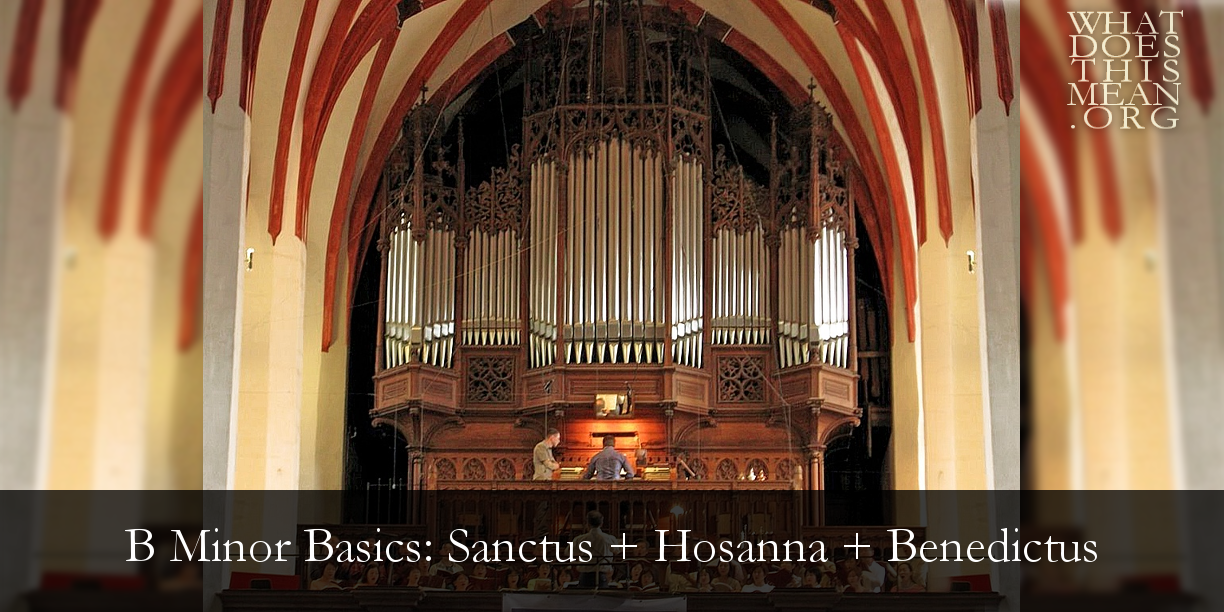To Thee cherubim and seraphim continually do cry:
Holy, holy, holy, Lord God of Sabaoth!
| Having set himself standards of scale, proportion and duration in his original Missa, which he then complemented so majestically with the Symbolum, he now had the task of sustaining the dramatic momentum and epic proportions, while putting together a final sequence of movements, unified and smoothly interlocked (BACH: Music in the Castle of Heaven, p. 514). |
The text of the Sanctus is from Isaiah 6:1-4:
| In the year that King Uzziah died I saw the Lord sitting upon a throne, high and lifted up; and the train of his robe filled the temple. Above him stood the seraphim. Each had six wings: with two he covered his face, and with two he covered his feet, and with two he flew. And one called to another and said: |
| “Holy, holy, holy is the Lord of hosts; the whole earth is full of his glory!” |
| And the foundations of the thresholds shook at the voice of him who called, and the house was filled with smoke. |
| Sanctus, sanctus, sanctus Dominus Deus sabaoth: Pleni sunt coeli et terra gloria ejus | Holy, holy, holy Lord God of hosts: heaven and earth are full of Your glory. |
If the Sanctus is the most majestic depiction of God in the B Minor Mass, then the Hosanna (“Save us now!”) is perhaps the most unique Turba or “crowd” chorus. The text of the Hosanna and the Benedictus are both from Psalm 118, a pilgrim’s Psalm that was sung by or to pilgrims as they journeyed to Jerusalem for the major feasts of the Old Testament. To depict this Psalm in music, Bach returns to normal instrumental scoring, but divides the choir into two choruses of four parts each. The result is a texture of some 20 parts (12 instrumental and 8 choral), the greatest number of parts used at any point in the Mass. In the following video, listen for the opening cry of “Hosanna,” followed by flourishes in the upper register (excelsis = “in the highest”) of the flutes, followed by the oboes, then the violins, and finally the trumpets. One can easily picture Jesus’ triumphant entry into Jerusalem, with pilgrims lining the streets to welcome the One who comes in the name of the Lord.
| Hosanna in excelsis. Benedictus qui venit in nomine Domini. Hosana in excelsis. | Hosanna in the highest. Blessed is He who comes in the name of the Lord. Hosanna in the highest. |
The late church historian, Jaroslav Pelikan (1923-2006), embodied the theological significance of Bach’s setting of the Sanctus, especially as he practiced the art of dying.
Shortly before his death, Dr. Pelikan, who was also a fine Bach scholar, was undergoing chemotherapy via intermuscular injection. Since the injection process took about two hours, he chose to listen to a recording of the B Minor (also about two hours in length) during each chemotherapy treatment. Could there be a more fitting use for an individual hearing of the Mass? How pertinent is the Sanctus and its companion movements at death’s door! The Sanctus unites heaven and earth around the throne of the Lamb (Rev. 4—5). Hosanna (“Save us now!”) is the plea of those who await the resurrection of all flesh. And the Benedictus describes all who die in the Lord and now rest from their labors. Perhaps the Te Deum, which includes the Sanctus (see the sub-heading of this article) puts it best: “We therefore pray Thee help Thy servants, whom Thou hast redeemed with Thy precious blood. Make them to be numbered with Thy saints in glory everlasting.”



 RSS Feed
RSS Feed
